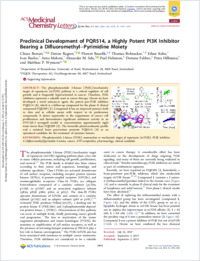Preclinical Development of PQR514, a Highly Potent PI3K Inhibitor Bearing a Difluoromethyl-Pyrimidine Moiety.
- Borsari C Department of Biomedicine, University of Basel, Mattenstrasse 28, 4058 Basel, Switzerland.
- Rageot D Department of Biomedicine, University of Basel, Mattenstrasse 28, 4058 Basel, Switzerland.
- Beaufils F PIQUR Therapeutics AG, Hochbergerstrasse 60, 4057 Basel, Switzerland.
- Bohnacker T Department of Biomedicine, University of Basel, Mattenstrasse 28, 4058 Basel, Switzerland.
- Keles E Department of Biomedicine, University of Basel, Mattenstrasse 28, 4058 Basel, Switzerland.
- Buslov I Department of Biomedicine, University of Basel, Mattenstrasse 28, 4058 Basel, Switzerland.
- Melone A Department of Biomedicine, University of Basel, Mattenstrasse 28, 4058 Basel, Switzerland.
- Sele AM Department of Biomedicine, University of Basel, Mattenstrasse 28, 4058 Basel, Switzerland.
- Hebeisen P PIQUR Therapeutics AG, Hochbergerstrasse 60, 4057 Basel, Switzerland.
- Fabbro D PIQUR Therapeutics AG, Hochbergerstrasse 60, 4057 Basel, Switzerland.
- Hillmann P PIQUR Therapeutics AG, Hochbergerstrasse 60, 4057 Basel, Switzerland.
- Wymann MP Department of Biomedicine, University of Basel, Mattenstrasse 28, 4058 Basel, Switzerland.
- 2019-10-18
Published in:
- ACS medicinal chemistry letters. - 2019
English
The phosphoinositide 3-kinase (PI3K)/mechanistic target of rapamycin (mTOR) pathway is a critical regulator of cell growth and is frequently hyperactivated in cancer. Therefore, PI3K inhibitors represent a valuable asset in cancer therapy. Herein we have developed a novel anticancer agent, the potent pan-PI3K inhibitor PQR514 (4), which is a follow-up compound for the phase-II clinical compound PQR309 (1). Compound 4 has an improved potency both in vitro and in cellular assays with respect to its predecessor compounds. It shows superiority in the suppression of cancer cell proliferation and demonstrates significant antitumor activity in an OVCAR-3 xenograft model at concentrations approximately eight times lower than PQR309 (1). The favorable pharmacokinetic profile and a minimal brain penetration promote PQR514 (4) as an optimized candidate for the treatment of systemic tumors.
- Language
-
- English
- Open access status
- hybrid
- Identifiers
-
- DOI 10.1021/acsmedchemlett.9b00333
- PMID 31620236
- Persistent URL
- https://folia.unifr.ch/global/documents/11167
Statistics
Document views: 18
File downloads:
- fulltext.pdf: 0
